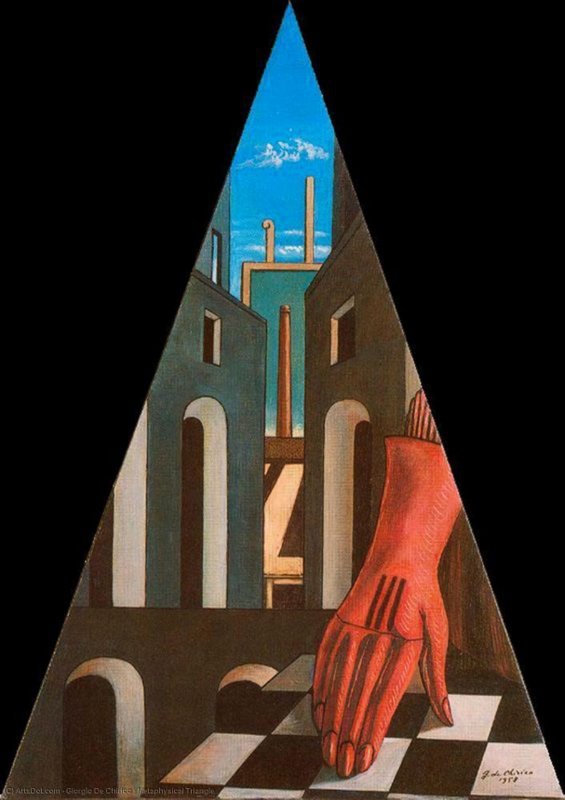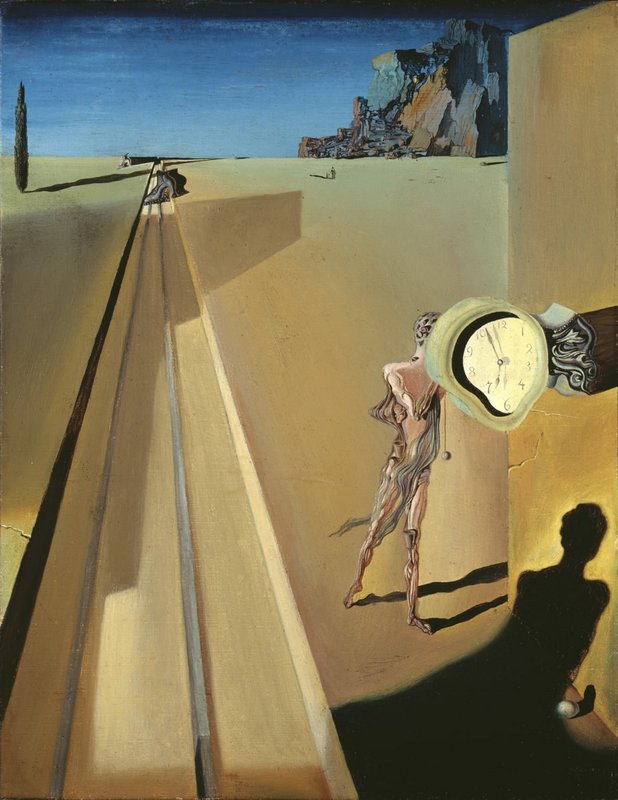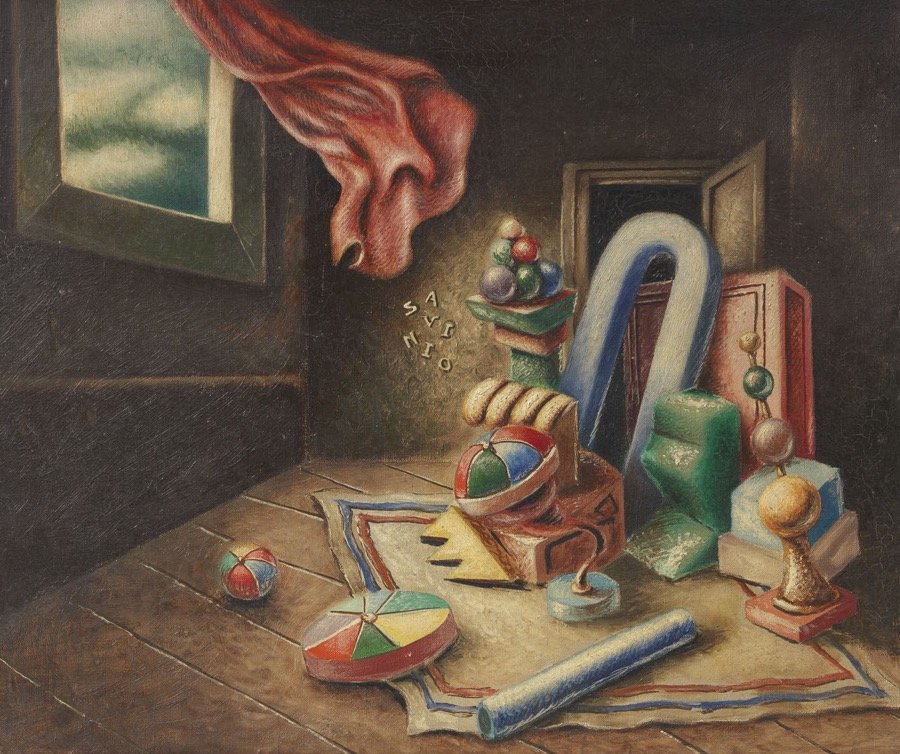|
Victor Brauner, Courteous Passivity, 1935
I became obsessed with the idea of the “façade.” Worcester’s skyline was no more than a series of cardboard cutouts. How strange it was that they had no
other side. They held back surging currents, the waves of a black ocean. To
peek behind them was to plunge into the depths. I could not stop myself; I
peeked. To believe that the city had more substance than a stage-set was to
fall victim to a form of hypnotic propaganda.
The Institute of Oceanic Flux sent agents to recruit me. Their instructional
method: dreams, quite often long. These provocateurs were somewhat less
active during the day. In their terrifying bird-masks, they would observe from
behind my shoulder. Should they reach out, they were anything but gentle,
and their claws would feel like vice-grips on my arm. These presences were
my protectors, my guides to the great society whose branches stretched far off
into the dark. Tangled beyond belief, and anxious to be fed, its roots were a
bloody map traced by the transmigration of lightning. I would be taken by the
hand, led layer by archeological layer down through the flames of collapsing
civilizations, the walls almost falling on my head, until, at the last moment, a
small passage leading to the next stratum would be found. Snakes would
whisk me across epileptic floods. The knowledge found in these chaotic states
was not meant to be accumulated; it was meant to be spent, to be only
partially grasped. I could barely do that much.
Images led to images. The chains of association sprawled in all directions.
Was this vision or schizophrenia? Few meanings could be solidified. As this
alternate space grew, I had to give myself instructions: “Remember, you must
eat. Put cheese on crackers. Pour milk in glass. There are your shoes. Do not
stare at the floor. Do you think that your shoelaces are going to tie themselves
? Why are you looking at your body from the corner of the room? Put your
eyes back in your head.” Sadly, no supernatural presence would appear on
call to help me with a math exam, nor would the World Snake lend me the
courage to ask Claudia Mulalley for a date.

Giorgio de Chirico, Metaphysical Triangle, 1958
“Sheathed in an iron glove,” I said, “let the hand of Fate, as in the 1914
painting by de Chirico, with a thunderous click put its finger on the
chessboard.” Already, and how many times, had the stage-props of the 20th
century been swallowed by the ocean, on one of whose waves I rode? Only
fools could believe that the First World War had begun in 1914. I saw my body
in a trench, parts gone, decommissioned. One self, out of hundreds. So much
for my avant-garde movement, my unpainted paintings, my unwritten books.
My heart was cold. There were no tears in my eyes.
Let the Untermenchen believe that each thing happened only once, and only
on a particular date, as if this war was somehow special because we had
forgotten all the others. It was “a” world war; by no means was it the first.
Through the mists of ancient history, I saw catastrophic die-offs, mass
exterminations. Soon my genius would transform and systematize the
dissociation of Pierre Lunaire. The moon was a vehicle. The true sun was
black. Pursued by implanted memories, we were pawns lost on a flood plain
of spent symbols, the victims of atomic bioengineering, the playthings of
omniscient beasts. We were the horizontal shadows thrown by a vertical
geometry. Our bodies were not other than symptoms. Our brains were the
materialized fallout left from the sabotage of the Hall of Records.

Salvador Dali, Premature Ossification of a Railway Station, 1930
I had discovered a poem by Cesar Vallejo that in part reads, “You people are
dead. But what a strange manner of being dead. Anyone might say that you
were not.” These were my thoughts, exactly. Each night, I continued my back
-breaking work on the scaffold of a Micronesian volcano, producing a few
more pages for my journal, a few more drawings. As the weeks drifted by, I let
a large amount of homework pile up. When I was able, finally, to yank my
attention back to school, I brought the 16-page megalomaniacal epic to show
to Mr. Sleeper, and I brought the best drawings from this series to show to
Mr. Trippi. (Bad teachers! Metaphysical pretenders! Guides who could not
read a map!) Neither of these mountebanks seemed to understand their job,
to play the role that I assigned them. Mr. Sleeper liked three lines. Certain
metaphors showed “promise.” Mr. Trippi did not seem to be amazed. As
Vallejo had warned, these people were dead, but so strange was the manner
of their being dead that I had been tempted to assume they were not.
Slowly, with an expression of deep thought, Mr. Trippi examined each one of
the several dozen pieces. He said almost nothing. Here and there he pointed
out some detail that he thought I might want to change. He would like to see
more color. Had I thought of doing these on a larger scale? In retrospect,
there was nothing he could have said that would have been adequate, or
enough. This could even be seen as a highly sensitive response. It is
unfortunate that things did not stop there. What happened next brought a
quick end to my experience in the class. It led me to block out whatever it was
that he might have had to teach.
Returning to his bull in the China shop mode, he insisted that I stay after
school for the next few days to complete the assignments I had not turned in.
These were a color chart and a still life with some fishing nets, driftwood, a
piece of cloth, and a bottle. This was like asking that I should do one of those
paint-by-number versions of Gainsborough. Blue Boy, a masterpiece in a box.
A painting to be hung above a couch. If I was an artist already, why would I
want to pretend to be one, to learn skills whose only purpose was to please
my bourgeois relatives? Like Miro, I wished to “assassinate painting.” Like
Breton, I believed that “Beauty will be convulsive or it will not be at all.”
My teacher’s words, as few and measured as they were, had unsettled me
more than I was willing to allow. I was not, in fact, a shaman. I could not
travel by choice from one place to another. No, I had to be carried. As my
model, Rimbaud, had advised in his 1871 letter to Paul Demeny, I had done
my best to derange my senses, but I seemed to have messed up on the
systematic part. I had not distilled any poison into its quintessence. I had not
come out the other side of madness. I was not yet a voyant. My explorations
led only to the knowledge of how much I had left to do. If I did have some
experience with vision, if I did feel the beginnings of some subtle form of
guidance, I was not, as of yet, an artist or a writer. After school, I hung around
for several hours, trying to imitate the grain on a piece of driftwood. I did not
return to class for the rest of the semester. Later in the year, I was allowed to
submit an independent body of work, and I squeaked by with a C.
Mr. Trippi came and went, like a mastodon in the moment before the glacial
crags descended. He was, of course, guilty of bad timing, a flaw in any
teacher, but also of violating the first commandment, which reads, “Do not
disrespect the Daimon. The primordial twin has no sense of humor.” Like
many adolescents, I could be faulted for a pathological inability to listen. I had
not yet found a way to take from each teacher what he or she had to offer, and
always, always, I demanded something else.
Now, at the age of 66, there are times when it seems that all perspectives have
reversed. Death is not what we call death, life is not what we call life, nor are
the two set in a simple binary opposition. What was large shrinks to the scale
of a small toy, as I study the young “Brian” through the wide eyes of his
Double. These physical events then appear in a ghostly light. These
unimportant echoes then speak to their subtle aspects.

Alberto Savinio, The Prisoners, 1931
Shortly before graduation, Brian ran into Mr. Tsang, his art teacher from
junior year. Mr. Tsang said, “What happened with Mr. Trippi? He was upset
that you dropped out of his class. He thought you had talent, and he was
doing his best to try to toughen you up, to teach you how to focus. You
wouldn’t look him in the eye. You wouldn’t answer when he asked you simple
questions, and then you just stopped doing your assignments. He couldn’t
guess what he’d done wrong.”
During the next few years, after Brian had moved to Boston to go to art school, he would return to visit his family once or twice a month. There, he would
sometimes see Mr. Trippi, wandering among the statues of the 19th century
heroes, wandering by the Dollar Store and the Paris Triple-X Theater,
wandering along the concrete margins of I-90, wandering among cars in the
parking lot of the Worcester Center Shopping Mall, blown here and there, an
autumn leaf.
An infinite ache would spread upwards from Brian’s solar plexus to his heart and then finally to his throat. Was this shrunken man the monster who would
stare into his eyes, whose hateful words had sent him running out the door?
Was this the fascist who had interrupted his early training as a shaman? Was
this the demiurge whose finger snap had once broken his connection to the
dream? No, he was just a retired high school teacher. He often looked quite
serious, having found out that his wife was very sick.
Mr. Trippi was the unacknowledged catalyst, the distorted face of the friend. Brian asked for certain lessons. Mr. Trippi offered others. He taught more
than he knew. He was the left hand of a broken god, an irrational number, a
stray quark, Phi’s infinite recursion, the flawed avatar who had all along been
important to my subject’s growth.
|